 |
|
 |
|
|
Home →
Publications →
Mother Earth News
|
|
Mother Earth News
Issue #110: The Tom Brown School (Wilderness Skills
Schools Part 3),
by Terry Krautwurst, pg50 (Mar-Apr 1988) |
|
|
|
A short course
in tracking, nature and wilderness
survival
I'm standing at the upper edge of an
overgrown hillside, a few sloping acres of knee-high grasses
and brush in rural western New Jersey. Above, half a dozen
raucous crows play in a blue sky—the definitive blue sky,
cloudless, crystal clear. Along the lower edge of the field
huge oaks and willows rise above lesser foliage, their boughs
arcing over a wide river, dappling the water in leafy shadow.
A typical countryside scene—unless you
include the 40 or so human posteriors and pairs of legs
grazing in groups scattered across the field. The bodies to
which they're connected are thrust out of sight into bushes
and briars and grasses, heads hidden like—well, no, not a bit
like ostrich heads hidden in the sand. Hardly evading the
world, these people are deep in discovering it.
This is the next-to-last day of a six-day
Standard (introductory) course at the Tom Brown School of
Tracking, Nature and Wilderness Survival. |
|
|
|
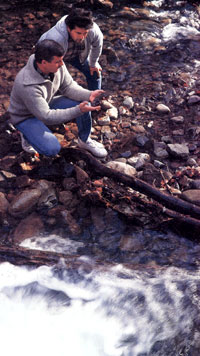 |
|
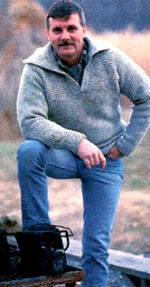
|
|
"The
Tracker" (above) stresses outdoor skills and respect for
the wild. Here he helps advanced students learn atlati
throwing (below) and select river stones for primitive
tool making. |
|
|
|
|
|
An excited voice emerges from somewhere
in a clump of sedge. "Tom! I found something! I think it's a
weasel hair!" A hand pops up, then a head. "Wow, look at
this!" another voice, belonging to a bluejeaned backside,
shouts. "Hey, I think I found a sleeping chamber!" someone
else hollers. "Look at all these trails!" an awed voice
exclaims, its legs snaking deeper into the vegetation.
The excitement of discovery is
contagious, and, dropping to my knees, I gladly shed my role
as observer/journalist, part a layer of matted grass, poke my
head downward and join my fellow students in a heretofore
unseen world. "I'll be damned," I whisper to myself as I
immediately uncover a tiny, wellworn path—too small for
rabbits, probably a vole run—winding around a sapling and
meandering downhill. "Would you look at that."
Belly down, nose inches from the ground,
I study the two-inch-wide trail, a Lilliputian highway paved
with grass pummeled smooth by countless wee footsteps. The
closer I look, the more I am drawn into life in this grass
forest, and the more I see: some droppings here, a hair there,
some tiny scratch marks, a rounded, nestlike chamber.
Carefully replacing the thatch above one section before
parting the vegetation over the next—as our instructors have
repeatedly reminded us to do—I trace the tunnel downhill.
Every few feet it intersects other paths, some hidden, some
exposed, some larger, some smaller—roads traveled by mice,
deer, foxes, ground hogs, raccoons. Together, I realize, they
form an amazing network, a sort of macrovascular system
pulsing with animal movement, that must cover the entire
field, and—good Lord, think of it—all the fields adjoining
this one, and all those adjoining them.
|
|
|
|
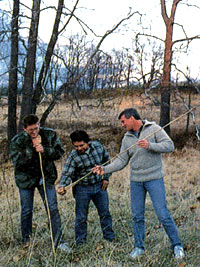 |
|
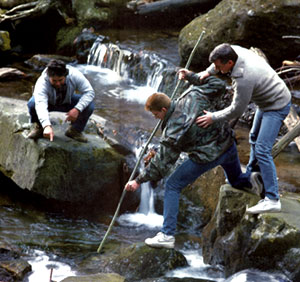 |
|
Gigging dinner with a homemade spear; a skill for
expert adventurers. |
|
|
|
|
|
Transfixed, I slither further into the underbrush.
Some minutes later, a sonorous voice
breaks the spell. "OK, people, gather round." I stand up,
blinking in the sunlight, in time to see my fellow students
emerge, heads popping up through the vegetation one by one,
like surfacing scuba divers. We assemble around our mentor,
Tom Brown, Jr., himself.
At 37, Brown is a teacher, author and
living legend. He looks the part. Over six feet tall, he
stands ramrod straight, a blue T-shirt stretched across a
broad chest and powerful biceps. His hair, showing streaks of
silvergray, is cut short, military style—a far cry from the
flowing tresses he has worn until only a few months ago. His
eyes are steel blue, piercing, always darting, never focusing
for long on any one person or thing.
Brown became a national figure in 1976,
when his first book, The Tracker, was published. The Tracker
tells the extraordinary story of Brown's childhood, spent
in the New Jersey Pine Barrens under the tutelage of an
elderly displaced Apache scout named Stalking Wolf. From the
time he was seven years old, he was trained by Stalking Wolf
in the old ways, the traditional skills and philosophies of
Native Americans. Brown believes, in retrospect, that he was
chosen by Stalking Wolf to pass along the ancient teachings
and skills.
In 1977 he started this school, today
probably the best-known and largest wilderness survival and
tracking school in the country. He has also written a set of
field guides, a second autobiographical book, The Search (a third is in the works), and
countless magazine articles, including a popular series, "At
Home in the Wilderness," for MOTHER.
But even before he started the school or
wrote his first book, Brown was known among law enforcement
and government agencies as "The Tracker." His exploits in
finding criminals and lost children, sometimes staying on the
trail without provisions for days, are epic. He is widely
acknowledged as
the best tracker in the country, period.
This week, though, he is our teacher, our
medicine man, our Stalking Wolf.
Brown gestures with a sweep of his arm to
the field and meadows adjoining. "People travel hundreds of
miles to crowd into places like Yosemite or Yellowstone to see
the wildlife," he says, "when there's so much to see and
appreciate right in their own back yards. A field like this
contains every bit as much wildlife, every bit as much natural
diversity and variety, as any park anywhere in the country.
And all you have to do is learn how to look for it. That's
all. Just learn how to look and see."
We have spent countless hours this week
doing just that, and a great deal more. In five days of
almost nonstop lectures and workshops—beginning at 8:00 each
morning and continuing into the night, sometimes past
midnight—we've covered an astonishing variety of skills, each
in depth: making fires, building shelters, finding water,
building traps and snares, skinning and tanning, making
natural cordage, cooking, arrow and bow making, flint
knapping, Eolithic rockwork, stalking, foraging, hunting
and—of course—tracking.
"I pack this course with information, and
then I pack it further," Brown told us the first night. "Time
is critical here. I use every minute. When you're done on
Sunday and you look at how much we've gone over, your head
will reel."
My head's been reeling since the second
day. I've filled two notebooks with lecture notes and I'm
working on another. My hands are scratched and calloused from
workshops: from carving traps, twisting plant fiber to make
cord, chipping rock into cutting tools.
After lunch, each student uses the time
remaining before the next class to practice skills or complete
projects started earlier. An options trader from Brooklyn
pulls a nearly completed bone arrowhead from his pocket and
begins scraping it across a piece of rock to give it a keen
edge. In the field beyond the cooking area, three students—a
real estate salesman, a machinist and a physical therapist—set
chunks of firewood on end in a line as targets, move back 30
feet and practice throwing a rabbit stick, an arm-length,
wrist-thick piece of tree limb that, when hurled correctly, is
a deadly accurate survival weapon for hunting small game.
Over by an outbuilding another student
stands staring straight ahead, arms outstretched to either
side, wiggling his fingers slightly. It's an exercise in
stimulating peripheral vision, an element, Brown says,
essential to increasing your awareness of the world. He has
taught us to widen our vision and avoid fixing our eyes in any
one direction for long—a technique he calls "splatter vision."
"Always be a tourist," he says. "Look at the room you're in,
the street you're on, the trail you're walking, as if you were
seeing it for the first time—no matter how many times you've
seen it before. Your mind always seeks the familiar, but you
miss so much. Vary your vision. Refuse to let your
eyes focus on the same things you always look at. Force
yourself to look in different places. Wherever your vision
goes, your senses go."
Other students are at the edge of a
cornfield, practicing the graceful, excruciatingly slow
movements we've learned for stalking. Still another is down on
all fours, notebook at side, imitating the basic animal
walking motions Brown has taught us. "You can't track an
animal if you don't understand how it moves," he says.
A shrill squeaking sound—wood rubbing
against wood—comes from behind me, and I cringe. I don't have
to look to know that it's a student working a bow drill, the
basic survival fire-starting apparatus consisting of a notched
fireboard, a dowellike spindle, a handhold, a small bow and a
tinder bundle. Making one, then starting a fire with it, was
our first workshop. In typical Brown fashion, we were provided
a chunk of cedar, the least desirable of acceptable woods. "If
you can get a bow drill fire going with cedar," Brown says,
"you can get one going with any of the better woods."
I'm embarrassed to be one of the few
students who have yet to succeed. I sigh. What the heck, I'll
try again. I get the drill I've made. I fluff up the tinder
bundle and lay it on the floor, place the fireboard over it,
wrap the bow's cord around the spindle, position the spindle's
bottom end on the board, put the handhold on the top end.
OK. Left foot anchors the fireboard.
Right knee behind left foot. Chest down tight against thigh,
left arm braced across shin. Start sawing with the bow, easy
at first, back and forth. Now pick up a little speed. Back and
forth, back and forth. Faster. Push down harder on the
spindle. There, some smoke. A little faster, bear down a
little harder (I'm running out of breath, my arm's cramping).
More smoke. Good, faster now, faster; push down a little
harder . . . pop, clatter . . . the spindle flies off the
board and across the room, just as it has countless times
before. Feeling beaten, I walk over and pick the spindle up,
forgetting that the end is hot, and burn my hand—injury added
to insult.
Just then Frank, one of the school's
instructors, comes around the corner. "Did you get your fire
yet?" he asks jovially. I grimace. "Look," he says, "let's get
together after tonight's lecture and see if we can't
figure out what you're doing wrong."
"Nah, thanks, that's OK," I
say, shrugging. "I'll just practice when I get home. It's not
that important, no big deal."
I lie.
The afternoon's tracking lecture, like
those before it, is electrifying. When Brown talks tracking,
his voice shakes with excitement, his eyes burn with
intensity, he paces back and forth, his hand flies across the
blackboard to illustrate a point. He is obsessed with tracking
and admits it. As a child, he developed a callus across his
lower chest from spending so much time crawling on the ground
poring over tracks.
"Every mark is a track," Brown teaches.
"Everything that is not flat is a track; the Grand Canyon is a
water track, a fallen tree is a track of the heartrot that
killed it and of the wind that felled it. Every dent, pocket,
fissure, scrape, mark in the ground, every rolling hill, every
scratch is a track. The ground is a manuscript, an open book;
it is littered with tracks, from the largest to the smallest,
and each one tells you something."
To me, the lectures are a revelation.
Brown's teaching goes way beyond merely identifying foot or
paw prints in the dirt. "Earth mother gives you a clear print
to follow maybe 5% of the time," he says. He teaches us
compression tracking—identifying vague depressions in the
ground or deep leaf litter or thin dust by their general shape
and the patterns in which they're arranged.
Then he moves to an even more subtle art,
the reading of what Brown calls pressure releases, the
characteristic ways the earth compresses, cracks, crumbles,
moves, responds to a foot or paw. There are hundreds of them,
and each means something different. There is a single release
that indicates an increase in speed from slow jog to jog,
another for a slight turn of the head to the right, another
for a momentary hesitation (perhaps the person or animal
considered changing direction for an instant, then decided
otherwise). Pressure releases tell all.
|
|
|
|
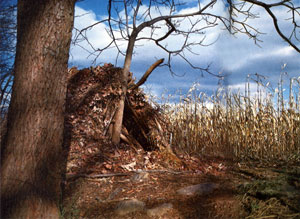
|
|
The
leaf hut is one of the simplest to construct, yet most
effective, emergency shelters. It offers a warm, dry
temporary home for the lost hunter or
hiker. |
|
|
|
|
"From one footprint," says Brown, "I can
tell a person's height and weight, gender, emotional state,
condition of health and degree of strength. I can tell whether
they're right- or left-handed, whether their stomach is full
or empty, whether they have to go to the bathroom. I can even
tell a few days before a person gets a cold, because there's a
restriction in breathing."
The lecture lasts well into the evening.
Brown's energy never abates. He draws dozens of release
patterns on the blackboard. He steps into a tracking box—sort
of a pro quality sandbox—and demonstrates how even subtle body
movements are revealed in prints. He is unrelenting. He
sketches more releases. He tells us of releases within
releases, of microreleases. We learn that all of the releases
we've discussed can be created not only by a foot or paw, but
by individual toes, by each lobe of an animal's heel pad.
It's simply too much for a mortal to
absorb. By the time we file out, I've filled my third notebook
and I'm brain dead, the victim of a tracking fanatic. I take
advantage of a rare lull in activities and tumble into my
sleeping bag.
Later that evening, an hour before we're
scheduled to partake in a traditional sweat lodge ceremony—a
culmination of the week's lessons—I walk into the wrong room
at the wrong time. A half dozen students are standing in a
loose circle cheering, and in the center a student who hadn't
yet managed to get a bow drill fire going is holding a flaming
tinder bundle.
They see me before I can back away. "OK,
Terry, you're next! You can do it! You've got to do it! Think
fire! Think fire!" Before I know it, I'm in the one place in
the world I least want to be, kneeling over a cold, hard
fireboard, bow in hand.
I start sawing away, back and forth, back
and forth. There's a wisp of smoke. I saw faster. More smoke.
"Go! Go!" the people in the background are chanting. I push
down harder, saw faster. A little more smoke. Back and forth,
back and forth, for what seems an eternity. Suddenly the smoke
billows and someone shouts, "You've got a coal, you've
got a coal!" I drop the bow, grab a toothpick-size twig
and gently nudge the coal into the tinder bundle. Carefully, I
pick up the bundle, cradle the coal inside the fibers and
bring the tinder to my lips. I blow gently. The coal glows
red, the tinder smokes. I blow again. It glows redder. I blow
again. The coal turns bright orange—and dies. A groan goes up
from the cheering section.
But I know what I've done wrong, and I'm
already sawing away again by the time my coaches are telling
me: "Feed the coal! You've got to keep the tinder all around
the coal!" The smoke billows again, I get a coal again, I tip
it into the tinder and bring the bundle to my lips again. I
fill my lungs with air and blow it out, long and steady. The
coal burns orange. I press the tinder inward, take another
breath, blow it out. More burn, more smoke. I keep the rhythm
going. Breathe in, blow out, more tinder, breathe in, blow
out. The smoke thickens and someone whispers, "He's got it,
he's got it." Breathe in, blow out, breathe in, blow-whoosh!
The bundle bursts into flames!
I am no shouter; at football games, a
muttered "All right" is the most I can manage when the home
team makes a touchdown. But at the sight of that fire, that
astonishing flame created from nothing, something way down
inside of me wells up and before I can catch myself I'm
standing and shrieking like a banshee, announcing with a
triumphant primal scream that I've made fire.
It is a night for profound experiences.
In the sweat lodge, there is no light, and in the darkness no
up or down, no sense of space or time. There is only the
heat—intense, purifying, drawing water from our bodies—and the
rhythm of our breathing, of Brown's voice chanting, of ebb and
flow. "Every drop of water contains a little bit of the
ocean," Brown has told us. "In the sweat lodge you can feel
the ancient pull of the tide, reminding you of your origins
and of the unity of all life."
We emerge from the lodge into a cold,
bright, crystalline night. I stand under the stars, throw my
head back to the sky and bask.
By 9:00 the next morning we're on our
hands and knees out in front of the barn with Brown, tracking
mice across the farm's hardpacked gravel driveway. I can't see
the tracks Brown points out until I heed his instructions:
"Always keep the track between you and the light, get close to
the ground, and look at the surface at a severe angle." I lean
way down, my eye an inch or two above the ground, low morning
sun opposite. There; so subtle they're barely more than a
reflection, the crucifix-like compression shapes
characteristic of rodents.
An hour later we're back in the
classroom. Most of us have to leave soon. "I have a confession
to make," Brown says. "I brought you here on false pretenses.
You came here to learn survival skills, and I've taught you
those skills. I know that with what you've learned you'll be
able to survive, quite comfortably, anywhere in the country as
long as it's not a parking lot. But that's not why I spent
this week with you." He pauses. His voice shakes with emotion.
"I believe we're fighting a desperate war to save what's left
of the earth from destruction. The earth is our mother. She is
lying raped and dying by the side of the road. She needs our
help. We have to help, or she'll die, and we with her.
"I believe that teaching survival gets to
people's hearts, that when a person learns how to enter the
world purely, unencumbered by society, where you live a
hand-to-mouth existence with the earth, a connection develops.
That's why I run this school, to bring as many people as
possible back to the earth, and to send them out to teach
other people."
Brown speaks slowly, pleadingly. "I hope
that when you go home you will have a new love and respect for
the earth, that you will have a commitment to help save it,
and that you will help bring others back close to the earth.
Please, people, take what you have learned here this week and
teach others. Time is running out."
The room is silent, charged with passion
and purpose.
By late afternoon, I'm on a crowded bus
headed back to the Newark Airport, Brown's words still ringing
in my ears. I'm leaving the school with far more than I
expected.
Am I an expert tracker? No, that'll take
time. But I've got an awfully good start. I've acquired
survival skills that I know will keep me alive should I ever
need them, and that in any case will allow me to hike, camp or
otherwise enter the natural world free of worry, free of what
Brown calls the "what if" question: What if I lose my
backpack, what if I break my leg . . . And I'll be able to
teach those same skills to my wife and children and friends.
Most important, though, I've gained a
greater sense of my place in the world and a heightened
awareness of the life around me. I have begun, in a small way,
to feel what the Native Americans called "the spirit that
moves in all things."
The bus pulls into the Newark Airport, a
hubbub of concrete and cars. It has been quite a week.
|
|
|
 |
|
•
•
•
•
•
•
•
•
•
•
|
 |
|
|
|
|

